
Key Takeaways
- Ducted systems distribute air through ducts to cool your whole house.
- Ductless AC systems offer flexible, efficient cooling without ductwork to individual rooms.
- Choose a ducted AC for whole-home cooling and a ductless system for flexibility and zoning.
Air conditioning is often one of the prime considerations when dealing with commercial or residential buildings. Whether you are renovating your house, or drawing up plans for your new dream home, you will inevitably be faced with the choice between a ductless system and a ducted one.
This can quickly become a daunting task.
Both ducted and ductless heating or cooling systems come in multiple types under several brands. In this guide, we will be covering all the basics about these two systems, along with the advantages and disadvantages of each. By the time you’re done reading this, you will be able to make a more informed decision about which system is best for your home.
- Ducted Air Conditioning Systems
- Types of Ducted Air Conditioning Systems
- Types of Ducts for Ducted Heating or Cooling
- Pros and Cons of Ducted Air Conditioning
- Ductless Air Conditioning Systems
- Types of Ductless Air Conditioning Systems
- Pros & Cons of Ductless Air Conditioning
- When Should You Opt For Ducted Air Conditioning
- When Should You Opt For Ductless Air Conditioning?
- Going for Both Ducted and Ductless Systems
- Ducted vs. Ductless Air Conditioning : Which Is Better?
Ducted Air Conditioning Systems

As the name suggests, ducted air conditioning provides heating or cooling through a system of ducts spread out all over your home or commercial space. A central unit, consisting of a condenser, compressor, and an air handling unit, is usually located in the basement, attic, or garage. It provides cool or hot air, which is then distributed throughout the building through a series of ducts and vents, providing the appropriate climate control.
Types of Ducted Air Conditioning Systems
Ducted systems are also called central air conditioning systems. They can be broadly segregated into two types, i.e., Split central air conditioners and packaged central air conditioners.
Split Central Air Conditioners
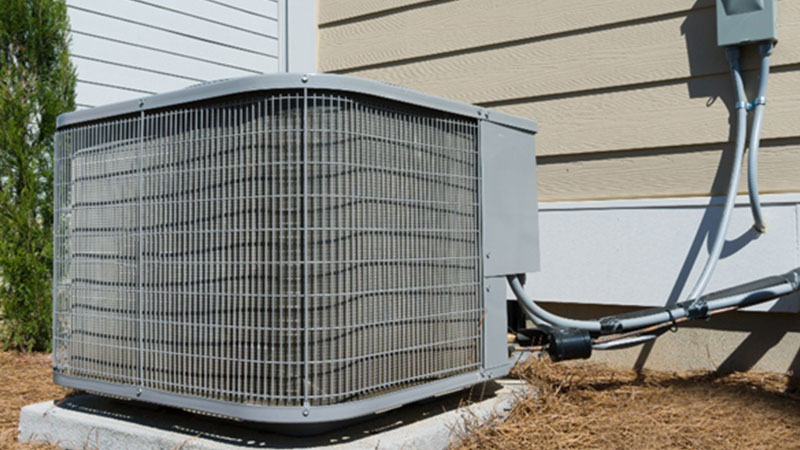
These systems are by far the most common type of central air conditioning system currently being used. They consist of the condenser and compressor placed outside in a metal cabinet in one package. A separate evaporator is placed indoors within a segregated container, usually located in a closet or the attic. The outdoor unit provides the refrigerant to the evaporator, which then cools the air and pumps it down the network of central air ducts through an air handling unit.
Equip your HVAC system with smart features and achieve the perfect balance between comfort & savings.
Learn more
Split central air conditioners are usually three times the size of an equivalent packaged central air conditioner. Splitting them in two makes the size much more manageable. Despite their size, split systems have higher SEER ratings than packaged air conditioners. In many split-system air conditioners, the indoor cabinet also contains a furnace or a heat exchanger of a heat pump. Moreover, split systems are an economical choice for homes that already have a furnace but no air conditioner as they can utilize the same furnace ductwork.
Packaged Central Air Conditioners
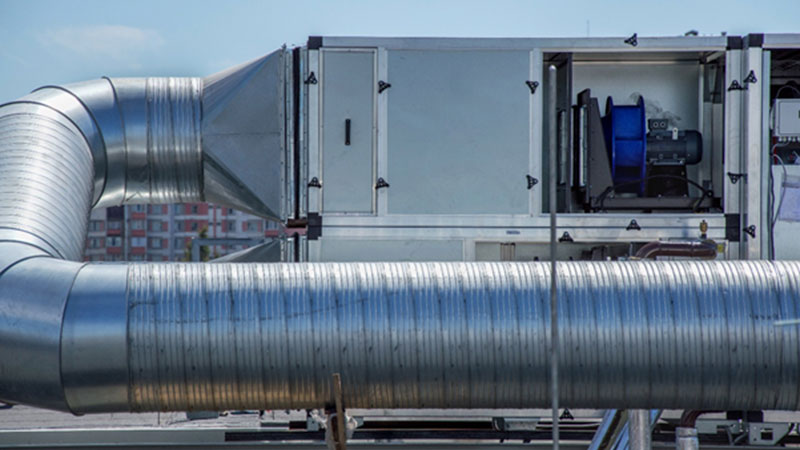
On the other hand, in a packaged central air conditioner, all the components, including the condenser, compressor, and evaporator, are in one single unit. You can either have these installed on a concrete slab next to your house or the roof.
This system is best suited for commercial buildings, or already built homes, where space can often be limited indoors. Central air ducts then circulate the air from the air handling unit into the room and move it back to the unit. These systems can be coupled with heating coils or furnaces to provide heating facilities too.
Packaged central air conditioning systems generally provide lower efficiencies than split systems but have the advantage of not taking up any space inside your home.
Before going for packaged central systems, be careful to check out your outdoor space well in advance. These systems can be heavy, so the roof should be able to handle the load adequately. Or, if you’re placing it on the ground, concrete emplacements need to be dug in beforehand.
Another important consideration while choosing ducted air conditioners is the ductwork. Regardless of which type of ducted air conditioning system you choose, central air ducts will take up a significant amount of space in your home. So it’s important to keep that in mind and see if a ducted system matches your home’s layout and design.
Types of Ducts for Ducted Heating or Cooling
Ducting makes up a major component of central air conditioning systems. Like with the main units, central air ducts also have various types based on the material used in their making. There are two central air duct types currently used:
1. Flexible Ducting

These AC ducts are tube-like structures with a large diameter. They consist of a metal framework surrounded by flexible plastic and insulation. This type of ducting is often cheaper and easier to install. It is best suited for confined spaces, where rigid structures can often be hard to install. It’s also useful for connecting rigid ductwork to the air outlet. An important point to remember while installing flexible ducting is ensuring that there are no kinks or bends, which might hamper airflow.
2. Rigid Ducting
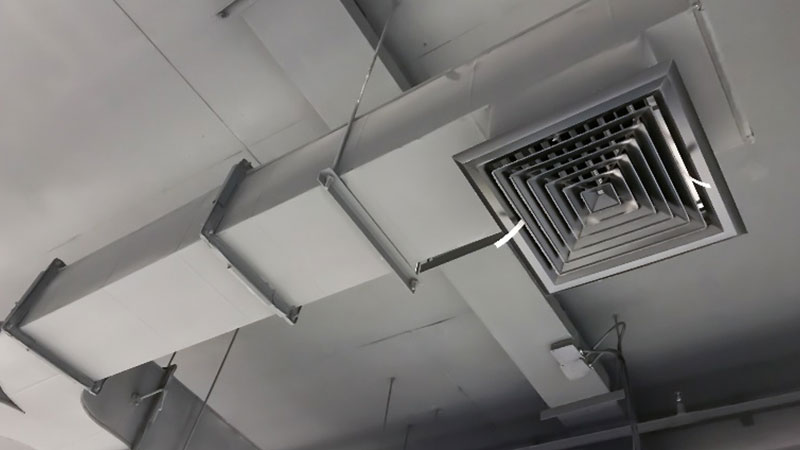
As the name suggests, these central air ducts are fixed structures that distribute air across an internal space. They are usually made of metal, making them sturdier and more durable than flexible ducts, but at the same time, harder to install. They are also much noisier since metal ducts can carry the racket of a blower much better than plastic ones.
The use of fiberglass insulation around the metal can help reduce the sound of air conditioning. But it has the disadvantage of being a potential health hazard, where deteriorating and old fiberglass lining can release particles into the air. Inhaling these particles can irritate the lungs. They can also end up causing skin irritation.
Pros and Cons of Ducted Air Conditioning
Now that we’ve had a general overview of central or ducted air conditioning systems, let us go over the pros and cons of them:
| Pros | Cons |
|---|---|
| According to the EIA, 91% of homes built in the US since 2000 have central ducts included. So chances are, you’ve already got a duct network within your property. If that’s the case, opting for a ducted air conditioner is a no brainer. This will also radically decrease the installation costs. | Ducted air conditioning usually have higher installation costs, especially if installation is being performed in an already installed property where duct space has to be made. |
| The vents used in ducted air conditioning systems give out an unobtrusive and discrete outlook. So if you are one for aesthetics, these systems are for you. | These air conditioners on the average, present lower efficiency ratings, called Season Energy Efficiency Ratios (SEER), for the same cost as their ductless peers. Leaks or damages to the ducts can further reduce the efficiency of the system, resulting in even higher operating costs. |
| Ducted air conditioning removes humidity at a much greater rate than its ductless counterparts. So, if you live in a humid environment where maintaining an ideal humidity level is a priority, these systems come out on top. | These systems are generally maintenance intensive, with ducts requiring regular upkeep and monitoring. According to the EPA, up to 30% of the air is lost through leaks, holes, and improperly installed joints within the AC ducts. |
| If your target space is a large room with many people inside, such as a restaurant or workspace, then ducted systems provide enhanced airflow than ductless systems. A greater rate of air flow ensures it never gets too stuffy, and you are constantly provided with fresh air circulation. | Mold in AC ducts can accumulate over time, and also serve as a breeding ground for insects. Such contaminants, when introduced to the room along with air, can result in allergies and diseases. |
Ductless Air Conditioning Systems
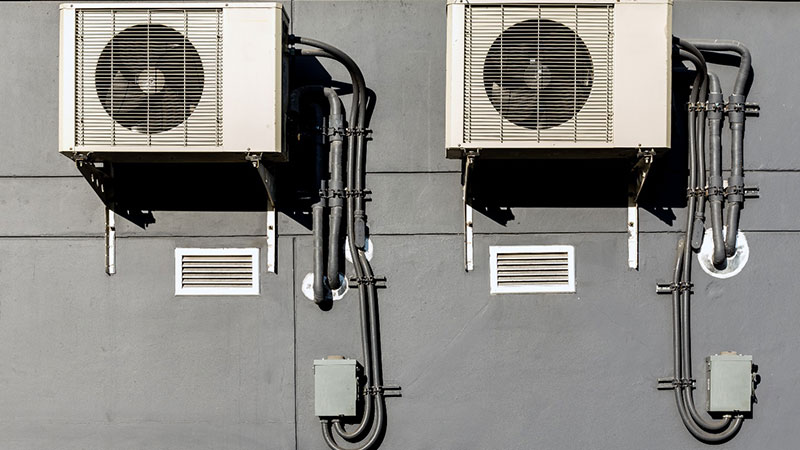
Ductless Air Conditioning systems do not require ductwork to move air around your house. Instead, ductless units blow cooled air directly into the living space, which makes them highly efficient. Ductless air conditioning systems have two main components: an outdoor unit and an indoor air-handling unit with an evaporator coil and fan. A copper conduit housing the power cable, condensate drain, refrigerant tubing, and suction tubing, links the outdoor and indoor units.
Types of Ductless Air Conditioning Systems
Ductless air conditioners are gaining popularity due to their multiple advantages. There are various types of ductless air conditioning systems and heat pumps in the market. These are normally conventional, but more modern smart varieties are also entering the market. While smart air conditioners can be costly, you can make any standard ductless AC smart using a smart AC controller.
Your best choice to make any mini-split, window,
or portable AC smart. Enhance your comfort and savings.

Let’s go over some of the major types:
Wall Mounted Mini Splits

Wall-mounted mini-splits go on any wall that has enough space outside it for the outdoor compressor unit. These go high up on the wall to keep the circulation of air effective (remember, cold air sinks!).
These wall-mounted ductless air conditioners are fairly easy to install and quite cheap, making them a popular choice among consumers. Furthermore, these air conditioners provide the flexibility of zone control, allowing the user to set the climate of each room individually. In addition, advancement in this technology allows these mini-split units to work as reversible heat pumps, supplying heat in the winter months.
Wall-mounted mini-splits can be single zone or multi-zone:
- Single Zone Mini Splits
Ductless single-zone mini-split air conditioners consist of an indoor unit and an outdoor unit placed outside. Both the units connect via a small pipe bundle, consisting of piping for the refrigerant, condensed water, and a power cable. This bundle of pipes, placed in a copper conduit, passes through a small hidden hole in the wall.
- Multi-Zone Mini Splits
These systems are very similar to single-zone mini-split air conditioners. The notable difference is that instead of one outdoor unit powering one indoor unit, the outdoor unit connects to multiple indoor units. The basic principle is the same, but a larger outdoor unit is necessary to meet the added needs of the numerous systems connected to it.
Window Units
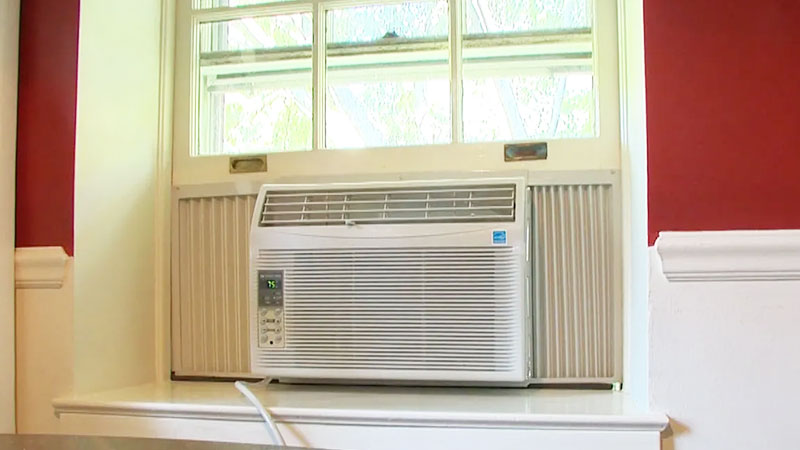
Instead of having a separate indoor and outdoor unit, the evaporator and condenser are packaged into one housing and installed on a window. The interior air is cooled by the evaporator, while the absorbed heat gets pushed outside. Multiple units may be installed within a large home, one in each room, to provide adequate cooling.
Portable Air Conditioners

With all the components housed in one package, portable air conditioners are similar to window air conditioners. However, the notable difference is that you can set up a portable ductless air conditioner anywhere, as required. The unit is usually on wheels or sufficiently lightweight so that you can move it around easily. These units have a hose that can be extended and placed outside to provide an outlet for the heated air venting from the condenser.
Ducted Mini-Splits
Ducted mini-splits, or concealed mini-split, provide the perks of both a ducted and a ductless air conditioning system. A mini-split unit connects to ducts that transport cooled or warmed air throughout your space. The mini-split duct connects to grills or registers that are barely visible in your room.
Floor Mounted Mini-Splits
As the name suggests, floor-mounted mini-splits have an indoor unit placed either on the floor or very close to it. These units are ideal for rooms with low-hanging ceilings or slanted walls. They’re also great for rooms with large windows that don’t leave enough space for wall-mounted units.
Cassette type Air Conditioners

Cassette air conditioners are usually recessed within the ceilings of the room, leaving your walls empty and not ruining the aesthetic of your room. Like other split units, they have an outdoor unit that transports the refrigerant to the indoor air handling blower via a conduit. They provide ample airflow from the four openings on each side of the unit. Therefore, they are best suited for larger rooms, such as shopping stores or workspaces.
Ducted Mini-Splits
Ducted mini-splits, aka concealed mini-split, provide the perks of both a ducted and a ductless air conditioning system. A mini-split unit connects to ducts that transport cooled or warmed air throughout your space. The mini-split duct connects to grills or registers that are barely visible in your room.
Pros & Cons of Ductless Air Conditioning
Now that we’ve had a general overview of ductless air conditioning systems, let us go over their pros and cons to help you make the best decision between ducted vs ductless air conditioning:
| Pros | Cons | |
|---|---|---|
| Ductless AC systems leave a much reduced footprint in the house than ducted ones. This is due to the absence of any ducting or a large condenser/air handling unit. This makes them ideal when renovating a space, where there is minimal room for ducts. | Ductless AC systems require a unit to be placed within the room. These can often be obtrusive and an eyesore. | |
| Mini-splits can give freedom to create multiple temperature zones. Each room’s temperature can be individually altered as per need, without changing the whole homes’ temperature. Even though you also have this option with ducted systems, they are usually expensive. | These systems have a higher initial installation cost than ducted systems. This can be recovered over their lifetime, but it depends on specific geographical conditions and AC usage. | |
| Due to their higher efficiencies, an increasing number of electric utility companies are now providing rebates and financial incentives to homeowners to install mini-splits. | They generally do not provide the large levels of air flow which are observed with ducted systems. If you’re looking to put in large volumes of air in a large space, then ducted systems are the better option. | |
| An increasing number of electric utility companies are now providing rebates and financial incentives to home owners to install mini splits, due to their higher efficiencies. | ||
| Inverter technology incorporated inside ductless systems enables the compressor to speed up or slow down as per demand, resulting in decreased energy usage. | ||
| Better air quality is obtained through the use of ductless systems. Absence of ducts removes any potential for dust and contaminants. Filters can be easily removed and cleaned, with newer models having air purifying technology built in. |
When Should You Opt For Ducted Air Conditioning
While both options have their perks and downsides, different systems are suitable under variable circumstances. Here’s when a ducted air conditioning system would be best for you when compared to a ductless unit.
- Your space has existing ducts: If your home has existing ductwork in a workable condition, it would be wiser and more cost-efficient to make use of them.
- You live in a humid space: Ducted air conditioning systems control humidity better. These systems will save you the trouble of getting a dehumidifier if you live in a moist region.
- You need improved airflow: They provide better air circulation since the central air ducts move air more efficiently throughout your space.
- You want a discreet solution: Everything is hidden away out of sight with ducted air conditioning systems, save for the registers. This system is ideal for people who want a cooling or heating solution that doesn’t ruin their home’s aesthetic.
- You want a low-maintenance solution: You only need to perform occasional cleaning and maintenance with ducted air conditioning systems. These systems have fewer components and therefore can require less upkeep. Ductless units are present in each room and all require separate maintenance.
When Should You Opt For Ductless Air Conditioning?
In certain circumstances, ducted air conditioning solutions might not be best for you. Here are all the times when a ductless air conditioning system would suit your needs:
- You have no room for ducts: If you live in a compact space where installing ductwork isn’t an option, or you don’t want to give you high ceilings up, a ductless air conditioning system would be ideal for you.
- You are adding to an existing space: A ductless system would be a cheaper option if you’re adding an extra room or are looking for additional heating/cooling in your grow room or shed.
- You don’t want dust in your space: Ductless air conditioning systems push air directly into your living space, which reduces the chances of them passing through dusty ductwork.
- You want multiple zone temperature control: You can have separate air handlers for all the rooms in your home and can control the cooling and heating settings for each one individually. This feature makes ductless systems great for people living in shared spaces, with everyone having different temperature preferences.
Going for Both Ducted and Ductless Systems
Ducted vs ductless is one debate, however there is also a middle ground. You can opt for ducted ductless cooling to benefit from the best of both worlds!
The ultimate goal is comfort, efficiency and convenience and opting for a combined ductless and ducted HVAC system can provide just that. You can easily add air conditioning in additional rooms such as a new shed, your garage or attic where it may be difficult and costly to install new ducts in a pre-built home.
Hot and cold spots in your home can be covered with a ducted ductless solution and if your house is prone to thermostat wars, a combination of both systems can provide individualized comfort!
Zoning and integrated controls for HVAC are other modern solutions to provide ultimate flexibility with a combination of ducted and ductless systems.
Ducted vs. Ductless Air Conditioning : Which Is Better?
There is no hard and fast rule about when to go for a ducted air conditioner or ductless. HVAC systems are a complex piece of engineering, with many considerations that need pondering over. The final choice boils down to your specific needs. Whether you are installing the system in an already built property or do you wish to build from scratch? What is the area of the space you are heating/cooling? What is your budget? Whether you want individual zonal control or not? All these questions, and many more, need to be answered before going out and buying a suitable air conditioning system. Happy hunting!









15 Comments. Leave new
My aunt is looking into purchasing a cooling unit for her new study room. I like your idea of investing in a ductless air conditioner if your house lacks the space to fit central ducts. Maybe we should find an AC contractor that could get one for her planned study room.
Nice Blog Post, Really a complete guide for ducted and ductless ACs.
Glad you liked it!
I live in Columbus Ohio where it’s humid n I live in a 1100 square foot mobile home home built in 1998 my air conditioner is gone what would you suggest I also face the west so I get the afternoon n evening hot sun. I’m also on oxygen 24:7
Hii, Fantastic blog! Thank you so much for sharing this kind of wonderful thing.
I would simply like to offer my kudos for [at least in my opinion] a well written article. It stated its intent of helping someone to be able to make an informed decision on a particular topic, for their specific needs; and then it did it.
That it was informative is obvious, but what’s more is that it was also very well organized, and contained proper, or effective, terms and terminology.
Thanks Rodriguez, glad you liked our content.
Thank you, this has been incredibly helpful. I have been focused on mini-split for metal barndo with an open cathedral ceiling layout (700 sq ft AIRNB). But we are in a high humidity environment so moisture removal is critical. My contractor has been advocating a conventional central air with exposed ducting. After reading your article, I think he is right.
Good article and very helpful content.
I am interested in ductless heat pump or ductless mini split. I have an all electric house that is cold and is very expensive to heat. I have radiant base board heaters. I don’t need A/C in the summer. I have large Coast Live Oaks and Redwoods blocking the sun and live in a valley in the hills so there is not many hours of sunshine in the day.
If you are looking to heat up individual rooms, a mini-split heat pump is an efficient option. Plus, it is really easy to install. You can also connect it with Cielo Breez smart AC controllers to give it smart capabilities. With Cielo Breez, you can control your heat pump using your phone, set daily/weekly schedules, save on heating bills, and so much more!
Excellent post.
Keep posting.
I didn’t realize that duct air conditioning systems remove humidity at a much greater rate then the other options. We just made a big move to Virginia, and have never lived in the humidity before. The home already has ducts for the heating system, would it be a good idea to install the AC as well to help with the humidity?
Central AC can considerably lower your humidity levels and make your home environment more comfortable. If you don’t want to utilize ductwork for cooling, you can choose a mini-split or window AC option.
I loved the part of your article that mentioned that ducted systems can remove humidity from a home much faster than other systems. This is because the weather in our area fluctuates very regularly, leading to some very sticky and humid days. To prevent this from becoming an issue for us, I’ll look for any HVAC contractors who can help us get a ducted system installed right away.